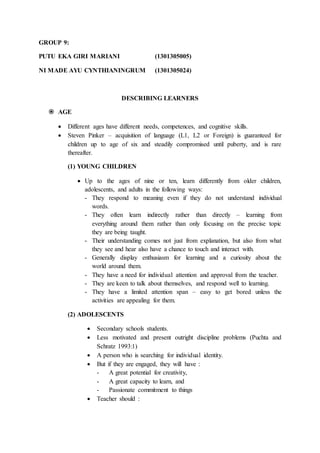
Describing Learners Ages, Styles and Motivation Factors
- 1. GROUP 9: PUTU EKA GIRI MARIANI (1301305005) NI MADE AYU CYNTHIANINGRUM (1301305024) DESCRIBING LEARNERS AGE Different ages have different needs, competences, and cognitive skills. Steven Pinker – acquisition of language (L1, L2 or Foreign) is guaranteed for children up to age of six and steadily compromised until puberty, and is rare thereafter. (1) YOUNG CHILDREN Up to the ages of nine or ten, learn differently from older children, adolescents, and adults in the following ways: - They respond to meaning even if they do not understand individual words. - They often learn indirectly rather than directly – learning from everything around them rather than only focusing on the precise topic they are being taught. - Their understanding comes not just from explanation, but also from what they see and hear also have a chance to touch and interact with. - Generally display enthusiasm for learning and a curiosity about the world around them. - They have a need for individual attention and approval from the teacher. - They are keen to talk about themselves, and respond well to learning. - They have a limited attention span – easy to get bored unless the activities are appealing for them. (2) ADOLESCENTS Secondary schools students. Less motivated and present outright discipline problems (Puchta and Schratz 1993:1) A person who is searching for individual identity. But if they are engaged, they will have : - A great potential for creativity, - A great capacity to learn, and - Passionate commitment to things Teacher should :
- 2. - Provoke student engagement with material which is relevant and involving Encourage the students to respond to texts and situations with their own thoughts and experience, rather than just by answering questions and doing abstract learning activities. Give them tasks which they are able to do, rather than risk humiliating them. Ask them to address learning issues directly. Discuss abstract issues with them. Provoke intellectual activity by helping them to be aware of contrasting ideas and concepts which they can resolve by themselves. (3) ADULT LEARNERS They can engage with abstract thought. They have a whole range of life experiences to draw on. They have expectations about learning process, and may already have their own set patterns of learning. Tend to be more disciplined and often prepared to struggle on despite boredom. Come to class with a rich range of experiences which allow teachers to use a wide range of activities with them. Often have a clear understanding of why they are learning and what they want to get out of it. But, they can be critical of teaching methods – previous learning experiences make them uncomfortable with the current unfamiliar teaching patterns. They may have experienced failure or criticism at school which makes them anxious and under-confident about learning a language. They worry that their intellectual powers may be diminishing with age. LEARNER DIFFERENCES 1. Aptitude (skills) test: to measure general intellectual ability 2. Good Learner Characteristics: - Tolerance of ambiguity - Ego involvement - High aspirations - Goal orientation - Creativity - Perseverance (persistence), etc. 3. Learner styles by Keith Willing : a. Convergers -Prefer solitary than groups - Independent -Confident in their own abilities - Analytic -Cool and pragmatic b. Conformist -Prefer to emphasise learning ‘about language ‘over learning to use it. -Dependent
- 3. -Perfectly happy to work in non-communicative classrooms -Prefers to see well-organized teachers. c. Concrete learners -Enjoy the social aspects of learning -Like to learn from direct experience -Interested in language use and language as communication rather than language as a system -Enjoy games and group work in class d. Communicative learners -Language use orientated -Comfortable out of class and show a degree of confidence -Willingness to take risks which their colleagues may lack -Much more interested in social interaction with other speakers of the language. -Perfectly happy to operate without the guidance of a teacher. - 4. MOTIVATION AND ATTITUDES a. Positive attitudes and motivation lead to success in L2 (Gardner, 1985). b. Robert Gardner and Wallace Lambert (1972) coined the terms : c. Integrative motivation – language learning for personal growth and cultural enrichment d. Instrumental motivation – language learning for more immediate or practical goals. e. Both showed a success in L2 learning. Motivation in the classroom setting Motivated students are usually those who participate actively in class, express interest in the subject-matter, and study a great deal. Graham Crookes and Richard Schmidt (1991) pointed the higher levels of interest in learning by : - Motivating students into the lesson - Varying the activities, tasks, and materials - Using co-operative rather than competitive goals Questions! 1. Why are they so much less motivated and why do they present outright discipline problems? 2. What are the implications of multiple intelligences for language teaching? 3. What are learners differences addressed as part of the educational system? 4. How can learning strategies improve the students' motivation to learn? 5. What are some of the factors of motivation? 6. What part does motivation plays in effective teaching?